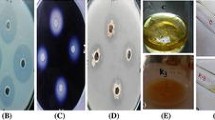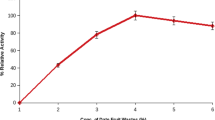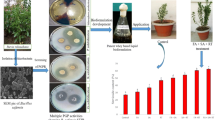Abstract
Globally the production of leather products is increasing day by day leaving detrimental solid and liquid wastes from tannery industries. This poses problem to human health and harm the related biota. Processing of these wastes leads to significant environmental pollution. To overcome this issue, converting these wastes into useful end products would be an alternative strategy for the bioconversion of waste into wealth. The present study aims to utilize tannery raw trimming bovine hide solid waste for the bioconversion as biofertilizer through fermentation by plant growth promoting bacteria. Tannery raw trimming bovine hide was screened for its physico-chemical properties and utilized for the isolation of protease producing bacteria also checked for plant growth promoting activity. It showed positive for production of ammonia and siderophore, and exhibited negative result for the production of IAA, HCN and phosphate solubilization test. By using 16S rRNA sequencing and phylogenetic tree analysis, the isolated strain was identified as Bacillus safensis. Media optimization was carried out to enhance protease production using statistical tools like PB, RSM. The tannery raw trimming bovine hides were fermented with Bacillus safensis and analyzed for NPK values since utilized for plant growth studies. After fermentation the solid hides were liquefied and NPK values were found to be 35 mg/L. This liquid was used for plant growth promoting activity using various concentrations on different plants like (Brinjal, Chilly and Tomato). The highest yield was found at the 50 ml concentration in all plants. Hence, it was concluded that our fermented liquefied solution could be used as biofertilizer for enhancing the promotion of plant growth. It is also employed as a methodology for reducing environmental pollution by the transformation of tannery raw hide solid waste into a commercially valuable product.









Similar content being viewed by others
Availability of Data and Materials
All data generated or analyzed during this study are original results.
References
Abdel-Hamid MS, Fouda A, El-Ela HKA, El-Ghamry AA, Hassan SE (2021) Plant growth-promoting properties of bacterial endophytes isolated from roots of Thymus vulgaris L. and investigate their role as biofertilizers to enhance the essential oil contents. BioMol Concepts 12:175–196
Abdullah RRH (2019) Insecticidal activity of Secondary metabolites of locally isolated fungal strains against some cotton insect pests. J Plant ProtPathol 10(12):647–653
Akinrinlola RJ, Gary YY, Rhae AD, Anthony OA (2018) Evaluation of Bacillus strains for plant growth promotion and predictability of efficacy by invitro physiological traits. Int J Microbiol 2018:5686874
Al-Bahadily DCH, Shari FH, Najm MAA, Al-Salman HNK (2019) Antimicrobial activity of the compound 2-piperidinone, N-[4-bromo-n-butyl] extracted from pomegranate peels. Asian J Pharm 13(1):46–53
Ami DV, Viral YS, Devayani RT (2019) Alkaline protease—a versatile enzyme. Int J Res Anal Rev 6(2):208–217
Arumugam N, Dhandapani B, Mahadevan S (2020) Optimized production of extracellular alkaline protease from Aspergillus tamarii with natural by-products in a batch stirred tank bioreactor. Prep BiochemBiotechnol 50(10):992–999.
Beryl GP, Thazeem B, Umesh M, Senthilkumar K, Kumar MN, Preethi K (2021) Bioconversion of feather composts using proteolytic Bacillus mycoides for their possible application as biofertilizer in agriculture. Waste Biomass Valorization 12(12):6795–6809
Bhat MA, Rasool R, Ramzan S (2019) Plant growth promoting rhizobacteria (PGPR) for sustainable and eco-friendly agriculture. Acta SciAgric 3:23–25
Bhattacharyya C, Banerjee S, Acharya U, Mitra A, Mallick I, Haldar A, Haldar S, Ghosh A, Ghosh A (2020) Evaluation of plant growth promotion properties and induction of antioxidative defense mechanism by tea rhizobacteria of Darjeeling. India Sci Reports 10:15536
Das S, Hasan A, Thomas T, David AA, Kumar T (2022) Assessment of chemical properties of soil collected from different blocks of west Medinipur district. West Bengal Pharm Innov J 11(6):641–646
El-Maraghy SS, Tohamy TA, Hussein KA (2020) Expression of SidD gene and physiological characterization of the rhizosphere plant growth-promoting yeasts. Heliyon 6:e04384
Faria F, Saba S, Waqar AK (2020) Nanoparticles as novel emerging therapeutic antibacterial agents in the antibiotics resistant era. Biol Trace Elem Res 199(7):2552–2564
Fathy SA, Mahmoud AE, Rashad MM, Ezz MK, Mohammed AT (2018) Improving the nutritive value of olive pomace by solid state fermentation of Kluyveromycesmarxianus with simultaneous production of gallic acid. Int J Recycl Org Waste Agric 7:135–141
Franco-Sierra ND, Posada LF, Santa-María G, Romero-Tabarez M, Villegas-Escobar V, Álvarez JC (2020) Bacillus subtilis EA-CB0575 genome reveals clues for plant growth promotion and potential for sustainable agriculture. FunctIntegrGenom 20:575–589
Ghosh SK, Bera T, Chakrabarty AM (2020) Microbial siderophore—a boon to agricultural sciences. Biol Control 144:104214
Gohil RB, Raval VH, Panchal RR, Rajput KN (2022) Plant growth-promoting activity of Bacillus sp. PG-8 isolated from fermented panchagavya and its effect on the growth of Arachis hypogea. Front Agron 4:805454.
Gondim R, Marinho R, Conceicao R (2015) Tanning handmade leather tilapia (Oreochomis sp.) from three natural tanning. Rev Bras de HigieSanid Animal 9(2):172–184.
Gou J-Y, Suo S-Z, Shao K-Z, Zhao Q, Yao D, Li H-P, Zhang J-L, Rensing C (2020) Biofertilizers with beneficial rhizobacteria improved plant growth and yield in chilli (Capsicum annuum L.). World J MicrobiolBiotechnol 36:86.
Hassan T, Naz I, Hussain M (2018) Bacillus cereus: a competent plant growth promoting bacterium of saline sodic field. Pak J Bot 50:1029–1037
Hur SJ, Lee SY, Kim YC, Choi I, Kim GB (2014) Effect of fermentation on the antioxidant activity in plant-based foods. Food Chem 160:346–356
Jatav P, Gupta A, Singh Ahirwar S, Jatav S, Jatav A, KushwahaK (2017) Production of plant growth hormones indole-3-aceticacid (IAA) using Bacillus by batch fermentation. Global J BiotechnolBiochem 6:612–616.
Kamaruzzaman MA, Abdullah SRS, Hasan HA, Hassan M, Othman AR, Idris M (2020) Characterisation OF Pb-RESISTANT plant growth-promoting rhizobacteria (PGPR) from Scirpusgrossus. Biocatal AgricBiotechnol 23:101456
Khalil RR, Madany MM (2017) Stigmasterol relieves the deleterious effects of copper stress in maize. Egypt J Exp Biol (bot) 13(1):99–110
Khalofah A, Ghramh HA, Al-Qthanin RNM, L'taief B (2022) The impact of NPK fertilizer on growth and nutrient accumulation in juniper (Juniperousprocera) trees grown on fire-damaged and intact soils. PLOS ONE 17(1):e0262685.
Khan A, Singh P, Srivastava A (2018) Synthesis, nature and utility of universal iron chelator—Siderophore: a review. Microbiol Res 212–213:103–111
Kumar S, Diksha SSA, Kumar R (2022) Biofertilizers: an ecofriendly technology for nutrient recycling and environmental sustainability. Curr Res Microb Sci 3:100094
Larkin RP (2020) Biological control of soilborne diseases in organicpotato production using hypovirulent strains of Rhizoctoniasolani. Biol AgricHort 36:1–11
Madan SS, Wasewar KL (2017) Optimization for benzeneacetic acid removal from aqueous solution using CaO2 nanoparticles based on Taguchi method. J Appl Res Technol 15(4):332–339
Maraz KM (2021) Benefits and problems of chrome tanning in leather processing: approach a greener technology in leather industry. Mater Eng Res 3(1):156–164
Mengistie GY, Awlachew ZT (2022) Evaluation of the plant growth promotion effect of Bacillus species on different varieties of tomato (Solanum LycopersicumL.) seedlings. Adv Agric 2022:1771147.
Mohammed AF, Oloyede AR, Odeseye AO (2020) Biological control of bacterial wilt of tomato caused by Ralstonia solanacearumusing Pseudomonas species isolated from the rhizosphere of tomato plants. Arch Phytopathol Plant Prot 53(1–2):1–16
Mokabel S, Olama Z, Ali S, El-Dakak R (2022) The role of plant growth promoting rhizosphere microbiome as alternative biofertilizer in boosting Solanummelangona L. adaptation to salinity stress. Plants 11:659. https://doi.org/10.3390/plants11050659
Nagarajan S, Eswaran P, Masilamani RP, Natarajan H (2018) Chicken feather compost to promote the plant growth activity by using keratinolytic bacteria. Waste Biomass Valorization 9:531–538
Nandiyanto ABD, Oktiani R, Ragadhita R (2019) How to read and interpret FTIR spectroscope of organic material. Indones J SciTechnol 4(1):97–118
Rath M, Mitchell TR, Gold SE (2018) Volatiles produced by Bacillus mojavensis RRC101 act as plant growth modulators and are strongly culture-dependent. MicrobiolRes 208:76–84
Razzaq A, Sadia S, Arfan A, Qurban A, Muhammad S, Arif M, Muhammad A (2019) Microbial protease applications. Front BioengBiotechnol 7:110
Rigueto CVT, Rosseto M, Krein DDC, Ostwald BEP, Massuda LA, Zanella BB, Dettmer A (2020) Alternative uses for tannery wastes: a review of environmental, sustainability, and science. J Leather Sci Eng 2(1):1–20
Saranya N, Lavanya N, Preethi K (2022) Biological liquefaction and dehairing of tannery hides using protease crude extract from Bacillus safensis. BiomedBiotechnol Res J 6:326–336
Saravanan A, Jeevanantham S, Narayanan VA, Kumar PS, Yaashikaa PR, Muthu CMM (2020) Rhizoremediation—a promising tool for the removal of soil contaminants: a review. J Environ Chem Eng 8:103543
Schwabe R, Senges CHR, Bandow JE, Heine T, Lehmann H, Wiche O, Schlomann M, Levican G, Tischler D (2020) Cultivation dependent formation of siderophores by Gordoniarubripertincta CWB2. Microbiol Res 238:126481
Sebastian AM, Umesh M, Priyanka K, Preethi K (2021) Isolation of plant growth-promoting Bacillus cereus from soil and its use as a microbial inoculant. Arab J Sci Eng 46:151–161
Selvaraj S, Jeevan V, Jonnalagadda RR, Fathima NN (2019) Conversion of tannery solid waste to sound absorbing nanofibrous materials: a road to sustainability. J Clean Prod 213:375–383
Sheng MM, Jia HK, Zhang GY, Zeng LN, Zhang TT, Long YH, Lan J, Hu ZQ, Zeng Z, Wang B, Liu HM (2020) Siderophore production by rhizosphere biological control bacteria Brevibacillus brevis GZDF3 of Pinelliaternata and its antifungal effects on Candida albicans. JMicrobiolBiotechnol 30(5):689–699
Stamenkovic S, Beškoski V, Karabegovic I, Lazic M, Nikolic N (2018) Microbial fertilizers: a comprehensive review of current findings and future perspectives. Span J Agric Res 16:e09R01.
Thazeem B, Preethi K, Umesh M, Radhakrishnan S (2018) Nutritive characterization of delimed bovine tannery fleshings for their possible use as a proteinaceous aqua feed ingredient. Waste Biomass Valor 9:1289–1301
Thazeem B, Umesh M, Mani VM, Beryl GP, Preethi K (2021) Biotransformation of bovine tannery fleshing into utilizable product with multifunctionalities. BiocatalBiotransform 39:81–99
Ulloa-Munoz R, Olivera-Gonzales P, Castaneda-Barreto A, Villena GK, Tamariz-Angeles C (2020) Diversity of endophytic plant-growth microorganisms from Gentianellaweberbaueri and Valerianapycnantha, highland Peruvian medicinal plants. Microbiol Res 233:126413
Verma T, Baiswar V (2013) Isolation and characterization of extracellular thermoalkaline protease producing Bacillus cereus isolated from tannery effluent. Int J Environ Sci 2:23–29
Ye D, Li T, Yi Y, Zhang X, Zou L (2019) Characteristics of endophytic fungi from Polygonum hydropiper suggest potential application for P-phytoextraction. Fungal Ecol 41:126–136
Zhou T, Huo R, Kwok LY, Li C, Ma Y, Mi Z, Chen Y (2019) Effects of applying Lactobacillus helveticus H9 as adjunct starter culture in yogurt fermentation and storage. J Dairy Sci 102:223–235
Zhou C, Qin H, Chen X, Zhang Y, Xue Y, Yanhe M (2018) A novel alkaline protease from alkaliphilic Idiomarina sp. C9-1 with potential application for eco-friendly enzymatic dehairing in the leather industry. Sci Rep 8:16467.
Acknowledgements
Author N. Saranya would like to express her heartfelt thanks to the Rashtriya Uchchatar Shikar Abhiyan (RUSA 2.0-BEICH), Government of India, Bharathiar University, for providing financial support throughout the project. Grant number: IQAC RUSA2.0/PF/2020/I dated February 3, 2020.
Funding
The study was financially supported by Rashtriya Uchchatar Shikar Abhiyan (RUSA 2.0-BEICH), Government of India, Bharathiar University, Grant Number: IQAC RUSA2.0/PF/2020/I dated February 3, 2020.
Author information
Authors and Affiliations
Contributions
Author NS performed the experiments, and analyzed the data, Dr. KP designed the work and manuscript editing.
Corresponding author
Ethics declarations
Conflict of interest
The authors have no competing interests to declare that are relevant to the content of the article.
Ethical approval
No experimental animals were used for this study.
Supplementary Information
Below is the link to the electronic supplementary material.
Rights and permissions
Springer Nature or its licensor (e.g. a society or other partner) holds exclusive rights to this article under a publishing agreement with the author(s) or other rightsholder(s); author self-archiving of the accepted manuscript version of this article is solely governed by the terms of such publishing agreement and applicable law.
About this article
Cite this article
Nachimuthu, S., Kathirvel, P. Bioconversion of Tannery Hide into Biofertilizer using Bacillus safensis as Plant Growth Promoting Bacteria and its Efficacy for Plant Growth Study. Iran J Sci 47, 1471–1485 (2023). https://doi.org/10.1007/s40995-023-01542-3
Received:
Accepted:
Published:
Issue Date:
DOI: https://doi.org/10.1007/s40995-023-01542-3




